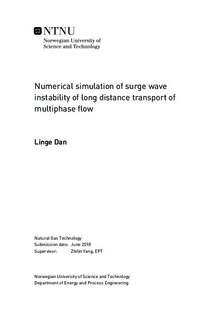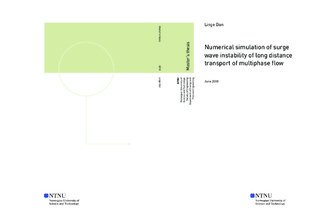| dc.description.abstract | The surge wave is an unstable flow phenomenon that may occur in the wet gas pipelines. The dramatic decrease in gas flow rate or the stopping of gas production due to other reasons would cause the liquid accumulation at the low spots of the pipelines, because the gas cannot drive the liquid forward. Ramp up again of the gas flow rate can make the accumulated liquid to be swept into the pipeline and at the same time cause the holdup peak to form surge waves. The surge wave propagates a long distance and has a long duration. Surge waves can carry a large amount of liquid which may exceed the capacity of the receiving equipment at the end of the pipeline and adversely affect the operation of the equipment, such as the separator.
Surge waves is a challenge for flow assurance. From the literature survey, OLGA predicted the surge wave of the three-phase flow earlier than the actual surge wave. The PMS (pipeline management system) module in Flow Assurance System is more useful in the prediction and simulation of surge waves for the field production. In the Mater thesis, the surge wave propagation of gas-liquid two-phase flow in long pipeline is the key research point. OLGA2016.2.1 and LedaFlow Engineering v2.3.254.029 were used to complete the numerical simulation.
The numerical simulation is divided into three parts. The first is to reproduce the experiments of gas-liquid two-phase surge wave completed at NTNU Lab by software, the pipeline was 57.84 meters in length and 60 mm in diameter. Comparing with the results of previous versions of the software, OLGA2016.2.1 had good simulation performance only at observation points near the entrance to the horizontal pipeline, and the simulations of the LedaFlow program for the surge wave were still not ideal, of the eight analysis cases, only two results were similar to the experimental results. The geometric configuration of the pipeline was modified to study the effect of up and down pipes on wave speed. This is useful for the geometrical setup of long-distance pipelines.
The simulation of long-distance pipelines is the second part of simulation, up and down pipes with uniform length were first considered. The whole pipeline has length of 1,325 meters and a diameter of 0.3 meters. There was a slug flow with 2.5 seconds, but the wave speeds of the up and down pipes were significantly different. The holdup reached the maximum at the first low spot, and then propagated forward and gradually decreases. When surge wave entered horizontal pipeline, the peak of holdup is around 0,012.
The downward pipe accelerates the wave speed. The existence of different wave speeds is the important condition for the merger of surge waves. By changing the geometric configuration of the long-distance pipeline, a pipe with a length of 850 meters and a diameter of 0.3 meters was set up, keeping all inclinations at 1.14 degrees. At the first low point of the pipeline, the holdup peak value was higher than that of in previous case, however, holdup value dropped also more dramatically.
Only one wave was set at the entrance, and the merge of the surge wave in the long-distance pipe cannot be observed, therefore two consecutive gas flow changes were introduced. When the first wave propagated forward, the second wave experienced the acceleration of the down pipe and could catch up with the first wave, so that before reached horizontal pipe, the two waves merged. And for this case, OLGA and LedaFlow had similar results.
Therefore, through numerical simulation, we can know that in practical production, the propagation of the surge wave is not a single wave forward, since the changes in the flow rate, the liquid accumulations in the low spots would flow by the form of surge wave after the flow rate recovers. Small surge waves merge with each other due to the shape of the pipeline or the terrain to form a large surge wave. The merger of waves makes the propagation of the entire surge wave to last longer.
The last part of the numerical simulation was based on field data. By adjusting the fluid flow rate during the running time, the phenomenon of surge wave can be observed, satisfying the fact that the flow regime was stratified, had a holdup peak, and lasted a long time. Therefore, the ability of the OLGA simulated surge wave can be evaluated. | |

